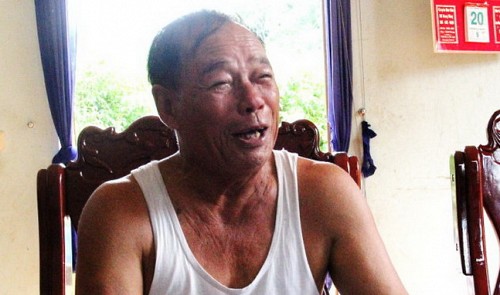There is a fishing village in Vietnam where all male adults ‘master’ the seabed of the country’s Hoang Sa (Paracel) archipelago like the back of their hand, so they learn by heart the currents of sea water and the terrain underwater.
They are the men in the Ganh Ca village by the coast of Binh Son District in the central province of Quang Ngai, who catch fish by diving.
Fish are plentiful in the sea waters of Hoang Sa, which is under the administration of Da Nang City, and Ganh Ca fishermen are seemingly born to work there.
Vo Bong is an 85-year-old fisherman from Ganh Ca and now takes daily physical exercise by walking along the coast in nice weather and sometimes looks up to the sky above the sea to ‘read’ the weather.
He pointed toward a group of men sitting and chatting by the coast and said, “Those young men are newcomers to diving at sea and are learning experience from elderly fishing retirees.
“All battle-hardened fishermen from Ganh Ca are now offshore in Hoang Sa.
“This windy weather is suitable to catch ‘vu nang,’ a favorite kind of snail in the archipelago.”
Holding a chopstick to draw on the ground a map of his village, Bong said all men from Ganh Ca have gone to Hoang Sa since it was under the feudal management of the Nguyen Dynasty hundreds of years ago.
Bong said his father sailed to ‘the golden sand beach’ – the Vietnamese meaning of the word ‘Hoang Sa’ – to catch fish when he was still a child, and his sons and grandchildren have been earning their living in the sea waters.
When he was of working age, he drove 20-30 horsepower boats to Hoang Sa, and his children are now operating 70-80 horsepower vessels.
“One day, other villagers and me went on three small motorboats to Hoang Sa and were beaten by a storm. The boats were heavily damaged,” Bong recalled one accident in his fishing career.
“In Hoang Sa, we repaired them ourselves and salvaged wooden pieces of the three boats to make them into one and boarded it to return to the mainland.”
Pointing at the ICOM, a device for communication between the mainland and fishing boats offshore, Nguyen Thanh Nam, a fishing veteran from the village, said Ganh Ca had over 20 fishing boats with 200 men aboard working in Hoang Sa that day.
Chinese ships managed to drive Vietnamese fishermen away, and the fishermen just ran around to avoid them for a time and continued anchoring to catch fish later, Nam said.
Nam is proud that all male adults from Ganh Ca have set foot on the Hoang Sa archipelago.
“For many generations, men here have closed their books and began holding ropes on fishing boats,” he said.
“Sons follow their dads and younger brothers follow the older to head toward Hoang Sa.”
The entire Binh Chau Commune has more than 200 fishing ships, each of which has at least 90 horsepower, and Ganh Ca has around 80 of them.
Ganh Ca fishermen are ‘on duty’ in the Hoang Sa sea waters all year round, Nam confirmed.
Fishermen from different localities are strong in different techniques to catch fish. Those from Nui Thanh District of central Quang Nam Province are good at catching cuttlefish, while their colleagues from Binh Dinh use netting in the deep water of a thousand meters. And Ganh Ca fishermen are only skilled in diving with three-pronged pitchforks.
“Before, fish were plentiful in Hoang Sa’s waters,” said the elderly fisherman Vo Hoa of Ganh Ca.
“We divers wandered around on islands to pick bird eggs during the day and dived to catch sleeping fish at night.
“Then fish were swimming as densely as they were kept in a cage, and fishermen feared big schools.
“We only targeted fish of at least four kilograms.
“Six fishermen dived three nights and caught full loads to head home.
“For cuttlefish, divers just turned on flashlights and they remained still.”
During the initial years after national reunification in 1975, fishermen could drive small boats without any positioning or telecommunication devices to catch fish in Hoang Sa, Hoa added.
“We know well the currents and just ran two days and two nights to reach Hoang Sa then,” he said.
Ganh Ca fishermen know the seabed of Hoang Sa like the back of their hand thanks to their diving skills.
Fisherman Pham Van Dai, 48, said Tri Ton Island in Hoang Sa has the most extraordinary shape, and from underwater it looks like a floating lotus leaf or a mushroom.
New fishermen thought that they were entering a cave when they dived under ‘the leaf,’ decorated with colorful coral reefs.

























































